Division bad weather. Missile corvettes of the Soviet Navy
Repeatedly observed that in the Navy navy The USSR had an amazing dependence: the smaller the warship, the more it was of use.
It is still not clear what the heavy aircraft carrier cruisers of the Soviet Navy were. Huge displacement ships under 50 thousand tons left behind only bitter annoyance: high complexity and high cost, lack of coastal infrastructure for their home and, in general, unclear mission made TAVKR ineffective and, quite simply, useless - none of the tasks initially assigned to them TAVKRI could not solve, and those tasks that they were able to solve were much cheaper and more effective ways.
Soviet cruisers and BOD acted much more confidently. The ships carried combat service in all corners of the World Ocean, were regularly in combat zones and vigilantly watched the forces of the “probable enemy”. Some even managed to “touch” the enemy live: in 1988, a modest BOD of the 2 rank (guard) “Selfless” with a steel squall crashed onto the deck of the USS Yorktown missile cruiser, demolished the half of the side, the launching boat and the MK-141 launch vehicle, and the MK-XNUMX launch unit was set by the pattern for launching the launch vehicle. . American sailors had to postpone Black Sea cruises until better times.
Nowadays, the "Selfless" rests on the bottom, and the US Navy ships are free to conduct exercises "Sea Breeze" in the Black Sea. The Montreux Convention forbids the presence of non-Black Sea warships in the Black Sea for more than 21 days, but the formality confuses the Americans a little - once every three weeks the ships leave for the Sea of Marmara, and come back a few hours later. Thus, the rescue ship Grasp of the United States Navy has been conducting diving work in the port of Odessa since May 2012.
If the ships of the main classes adequately represented the interests of the USSR in the expanses of the ocean, then rocket boats of Soviet construction, to put it in the Internet jargon, simply burned. In the literal sense burned down destroyers, transport ships, boats ... Any adversary was allowed into the expense. Small ships were actively supplied to the Third World Navy, which further increased the likelihood of their combat use.
Sometimes it seems to me that too much importance is attached to the sinking of the destroyer Eilat - the rocket boats have other remarkable victories. For example, daring raids on Karachi of the rocket boats of the Indian Navy (Soviet 205 Ave) in December 1970. Several Pakistani warships and three vehicles were sunk. In conclusion, a magnificent firework was given - the P-15 missiles blew up the 12 huge reservoirs of the oil storage tank located on the shore.
The development of electronics and rocket technologies has allowed to create even more formidable weapon. The evolution of rocket boats in the USSR led to the creation of a completely new class of warships - a project of a small rocket ship with an easily remembered 1234 cipher.
Gadfly
Clot of combat matter by a total displacement of 700 tons. Full speed 35 knots. The cruising range of the economic route allows you to cross the Atlantic Ocean (4000 miles on 12 nodes). Crew - 60 man.
MRK pr. 1234 is not by chance called the “gun at the temple of imperialism.” The main caliber - six launchers of anti-ship missiles P-120 "Malachite"! The name of the complex directly indicates the calculated firing range - 120 km. The starting weight of the monstrous ammunition - 5,4 tons. The mass of the warhead - 500 kg, some missiles equipped with a special warhead. Missile march speed - 0,9M.
Also, the armament complex of a small rocket ship included:
- “Osa-M” SAM for self-defense of a ship (20 anti-aircraft missiles, effective firing range - 10 km, reloading time of the launcher - 20 seconds. Mass of the launcher without ammunition - 7 tons).
- twinned artillery system AK-725 caliber 57 mm (later replaced by 76 mm single-barrel AK-176)
- the upgraded MRK pr. 1234.1 were additionally equipped with an 30-mm AK-630 machine gun installed in the rear part of the superstructure.
Even with the naked eye it is noticeable how much the ship is overloaded with weapons and combat systems. As for the sober assessment of the RTOs pr.1234, the sailors treated these ships in two ways: on the one hand, the salvo is equal in power to several Hiroshima, on the other hand - low survivability, poor seaworthiness and very little chance of reaching a missile attack range. The US Navy command was skeptical of the "missile frigates": aviation AUG per hour examines 100 thousand square kilometers of space - the Russians should be great optimists in order to count on getting unnoticed. The situation was aggravated by the standard problem in naval combat - target designation and guidance. Own radio-electronic means of RTOs allow detecting surface targets at the range of the radio horizon (30-40 km). Firing missiles at full range is possible with external target designation equipment (for example, Tu-95RTs aircraft). And yet, the enormous power of these small ships made even the 6th US fleet reckon with them. Since 1975, small missile ships began to regularly be included in the 5th operational squadron of the Black Sea Fleet: numerous and ubiquitous, they created many problems for American sailors.
Despite its direct mission - fighting against ships of a “probable enemy” in the closed seas and the near ocean zone — the RTOs of 1234 Ave. successfully carried out the tasks of protecting the state border, providing combat training for aviation and navy, and even used them as anti-submarine ships. not having on board specialized means to combat submarines.
A total of 1234 small rocket ships of various modifications were built under the 47 project: 17 for the base project, 19 for the advanced 1234.1, 10 MRK in the export version of 1234 and 1234.7 Nakat (with Malachite instead Onyx missiles are installed).
In addition to the emergence of new weapons systems and jamming stations, one of the invisible from the outside differences between the MRC Ave 1234.1 and the base case was the presence of on-board fire ovens - now the sailors were provided with freshly baked bread.
The dimensions of the hull of export ships pr. 1234E remained the same The power plant consisted of three diesel engines with 8600 power. with providing full speed 34 knots. (on the base project stood engines 10 ths. hp) The crew decreased to 49 people. For the first time, on the export versions of the ISCs, to improve the living conditions of the crew, conditioners and an additional refrigerator were installed.
The shock armament has changed: instead of anti-ship missiles "Malachite", the ships received anti-ship missiles P-15 in two paired PUs, located along the board. In addition, to increase combat stability, two PU PC-16 were added for setting passive jamming. Instead of the RLC “Titanit”, the old “Mastout” radar was installed, at the same time, an impressive cap from the “Titanit” radar was retained for solidity.
All small rocket ships were assigned “weather” names, traditional for the heroic patrol ships of the Great Patriotic War - “Breeze”, “Monsoon”, “Fog”, etc. For this, the ISCs were called the “bad weather battalion”.
Results in the dash: Ivanov → milk, Petrov → milk, Sidorov → Petrov
Many of the P-15 end-of-life missiles ended their career as air targets to provide combat training for anti-aircraft gunners. When a missile was transformed into a PM-15M target, the homing head was switched off on it, and the warhead was replaced with ballast. 14 April 1987. Pacific Fleet conducts combat training for refining missile attacks. Everything happened in all seriousness: the “Monsoon” MRK, the “Whirlwind” MRC and the IPC No. XXUMX formed an order for which the missile boats fired from the distance of 117 km.
It is still not clear how this could happen. Self-defense weapons failed to repel the attack, and the target missile with an inert warhead struck the superstructure of the Musson MSC. Some witnesses to the tragedy had the impression that the homing head of the target missile was not turned off. This was indicated by the trajectory of the rocket’s flight and its “behavior” in the final section. Hence the conclusion was made: on the base, criminal negligence was allowed, forgetting to turn off the rocket’s GOS. The official version says that something like that so accidentally, when flying along a ballistic trajectory, the rocket did not hit the MRK Musson. The invisible hand of providence, the ship was destined to die that day.
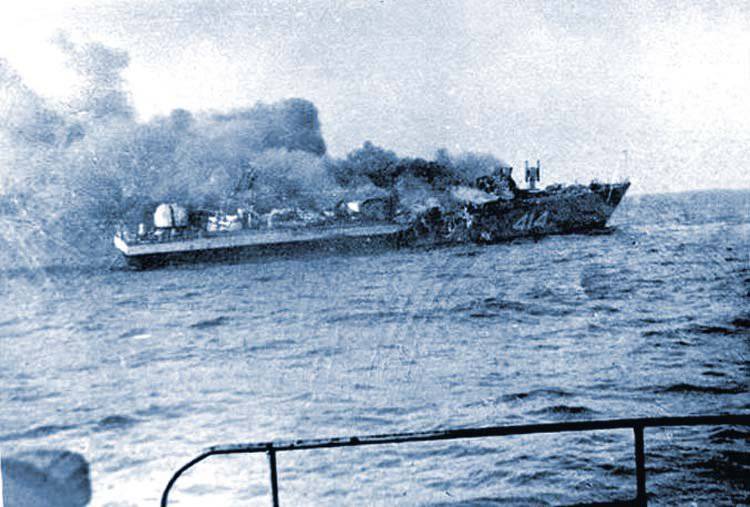
The components of the rocket's fuel caused a voluminous explosion and an intense fire in the interior of the ship. In the first second, the commander and most of the officers, as well as the first deputy commander of the Primorsk flotilla, Admiral R. Temirkhanov, were killed. According to many experts, the material from which the designs are made not only of the "Monsoon", but also of almost all modern warships, has become the cause of such a violent fire and poisonous smoke. This is an aluminum-magnesium alloy - AMG. Material killer contributed to the rapid spread of fire. The ship was de-energized, lost internal and radio communications. Stopped fire pump. Almost all hatches and doors jammed. The fire system and irrigation systems of the bow and stern cellars of ammunition were destroyed. In order to avoid a premature explosion, the sailors managed to open the cellar covers with anti-aircraft missiles in order to reduce the internal pressure.
After checking the temperature of the bulkheads in the area of the 33 th frame, behind which the cellar with anti-aircraft missiles was located, and making sure that the bulkheads were red-hot, the sailors realized that the ship could not be helped.
At night, the “Monsoon” MRK sank in 33 miles south of Fr. Askold, carrying the burnt bodies of 3 to the depth of 39 kilometer.
After the destruction of the Sheffield URO destroyer from the unexploded Exoset missile in 1982, Western military experts concluded that a large number of different combustible materials, in particular, aluminum alloys, contributed to the rapid spread of fire. From 1985 onwards, American ship add-ons are covered with silicate felt insulation combined with fiberglass. British engineers have developed insulation called "conflame" to protect structures from fire. Nevertheless, alloys from AMG are still widely used in the construction of ships.
And this could be called an accident, but once it turned out to be not enough. 19 April 1990 was conducted training and combat firing on the Baltic to test off a rocket attack. Under similar circumstances, the target rocket hit the Meteor IRA, shooting down several antennas on the ship's superstructure. Fly a little lower - and the tragedy could happen again.
"Missile corvettes" in battle
During the incident in the Bay of Sidra (1986 year), the US cruiser USS Yorktown (the same Black Sea “hero”) discovered a small-sized target 20 miles from Benghazi. It was the Libyan IRA "Ein Zakuit", crept to the Americans in radio silence mode, imitating a fishing vessel. Even a short-term (only two turns of the antenna) radar inclusion unmasked a small rocket ship and disrupted the attack. With the launch of two “Harpoon” missiles, the MRK was set on fire and sank in 15 mines. There is still no exact description of that battle: some sources attribute the death of the RTOs to successful operations of carrier-based aviation. Also, the Americans call another small airship "Vokhod" destroyed by airplanes. It is reliably known that yet another Ein Mara MRC suffered in this battle - he had to undergo emergency repair with the elimination of combat damage at the Primorsky plant in Leningrad, in 1991, he returned to the Libyan fleet under the name "Tarik ibn Ziyad ".
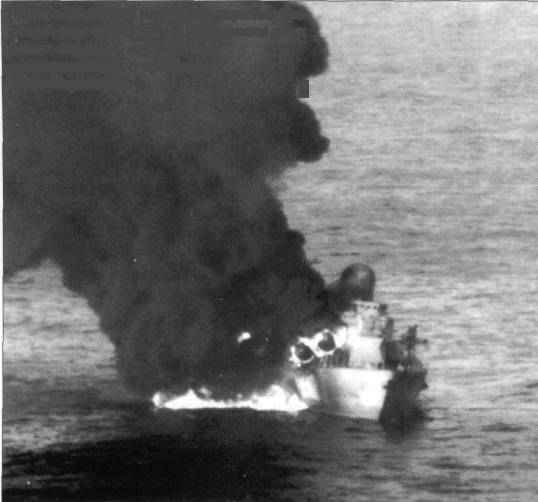
If, on the basis of these data, dear readers conclude about the weakness and uselessness of RTOs of 1234, I suggest that you read the following history.
Battleship off the coast of Abkhazia 10 August 2008 was the first serious military clash of the Russian Navy in the twenty-first century. Here is a brief chronology of those events:
On the night of 7 on 8 of August 2008, a detachment of Black Sea Fleet ships headed for Sukhumi from Sevastopol Bay entered the sea. The detachment included a large landing ship "Caesar Kunikov" with a reinforced company of marines on board, and its escort - the Mirage "Mirage" and a small anti-submarine ship "Muromets". Already in the march a large landing ship "Saratov" joined them, departing from Novorossiysk.
On August 10, five high-speed Georgian boats left the port of Poti to meet them. Their task is to attack and sink our ships. The tactics of attack are well known: high-speed small boats, equipped with powerful anti-ship missiles, suddenly strike the large landing ship and leave. If successful, the result is "shock and awe." Hundreds of dead paratroopers, a burned-down ship and Saakashvili's triumphant reports: “We have prevented intervention”, “The Russians have no fleet, they are not capable of anything”. But it turned out the opposite. "Vesti" managed to collect detailed information from the participants of this battle:
18 hours 39 minutes. The Russian radar reconnaissance detected several sea high-speed targets, which were marching to build our ships.
18.40. Boats of the enemy approached at a critical distance. Then from the flagship "Caesar Kunikov" was given a volley from the MLRS A-215 "Grad". This does not stop the Georgians, they add speed and try to reach the so-called "dead zone", where rocket weapons are useless. Small rocket ship "Mirage" receives an order to destroy the enemy. The distance to the target - 35 kilometers. Preparing for the strike, calculations - everything was done in just a few minutes. Battleship is always transient.
18.41. The commander of the Mirage gives the command "Volley!". The first rocket went to the target. After a few seconds - the second. The flight time to the Georgian “Tbilisi” boat is just 1 a minute 20 seconds. The distance between opponents is about 25 kilometers.
The first rocket hit the engine room of the Tbilisi boat. A second later - another report - the second hit in the wheelhouse. On the radar of our ship for 30 seconds there was a strong flare, which means complete destruction of the target, accompanied by a large emission of thermal energy.
18.50. The commander of the "Mirage" gives the command to change positions. The ship at high speed goes towards the coast, makes a U-turn and again falls on the combat course. Radar shows only 4 targets. One of them is the Georgian boat, having increased the speed, again goes on rapprochement with our ship. "Mirage" opens fire from the OSR "Wasp".
At this time, the distance was reduced to 15 kilometers. The rocket hits the side of the Georgian boat, which immediately began to smoke, slowed down and tried to leave the line of fire. The rest of the Georgian ships leave the battle, turning sharply in the opposite direction. "Mirage" does not pursue the downed enemy, there is no order for finishing.
From the report of the commander of the IRA “Mirage” to the flagship: “Of the five targets, one has been destroyed, one is damaged, three are out of combat. Missile consumption: anti-ship - two, anti-aircraft - one, no losses among the personnel. No damage to the ship. "
As of 2012, the Russian Navy has 10 IRAs Ave. 1234.1 and 1 IRAs Ave 1234.7. Considering the difficult state of the Russian Navy, these modest ships are a good support - their operation does not require large expenditures, at the same time, they fully retained their fighting qualities, which once again confirmed the sea battle off the coast of Abkhazia.
The main thing is not to set impossible missions for small rocket ships; other means should be used to counteract aircraft carrier strike groups.
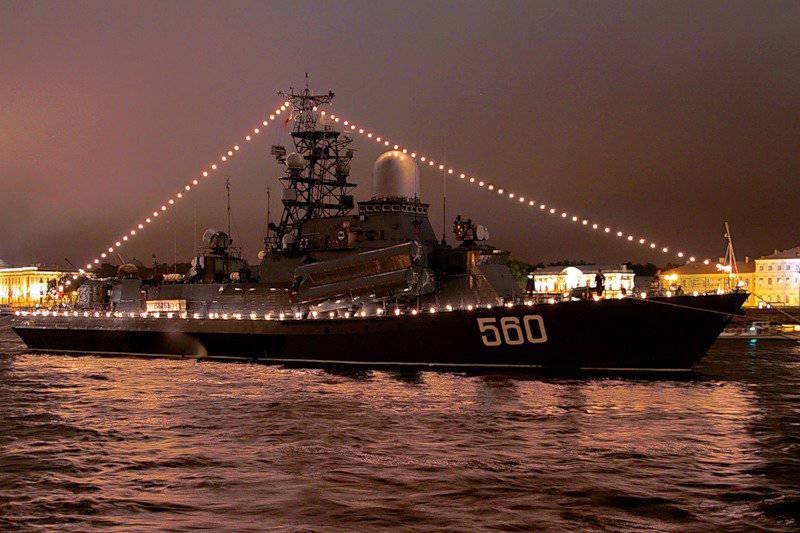
The tradition of creating highly efficient naval weapons has not been forgotten - a series of 10 small rocket ships of the 21631 Avenue Buyan is planned to be built in Russia. The total displacement of the new type IRAs will increase to 950 tons. Water jet provides speed 25 nodes. The strike armament of the new ship will intensify due to the appearance of the Universal Ship Shooting Complex (UCSC) - 8 launch cells for launching Caliber family missiles. The head MRK pr. 21631 “Grad Sviyazhsk” was already launched, in 2013, it will be added to the combat strength of the Caspian flotilla.
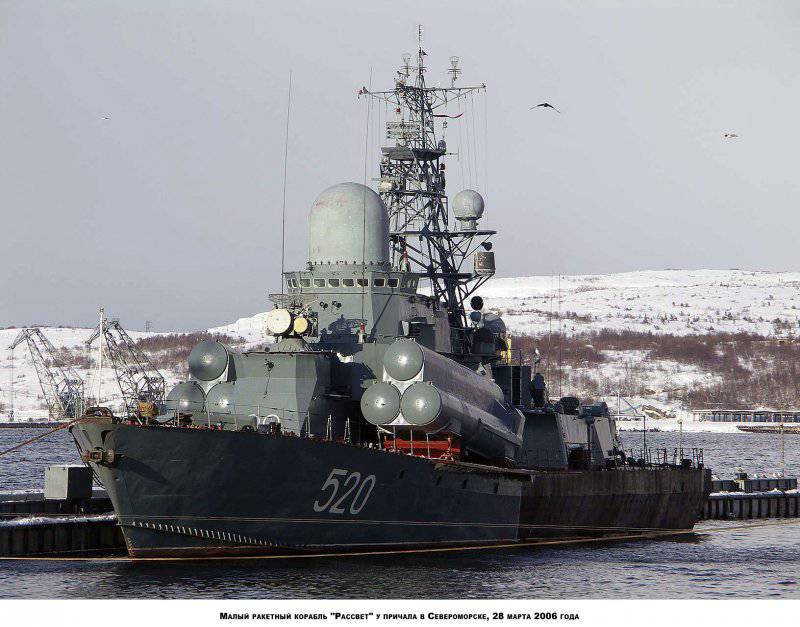
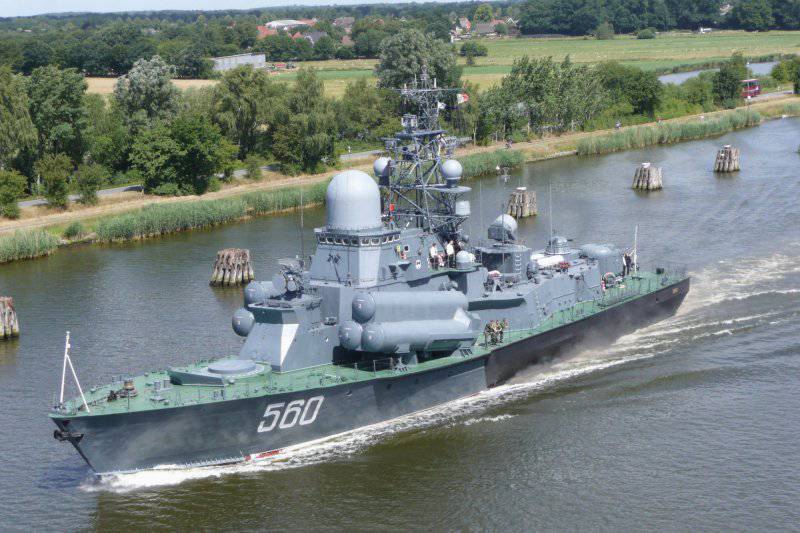
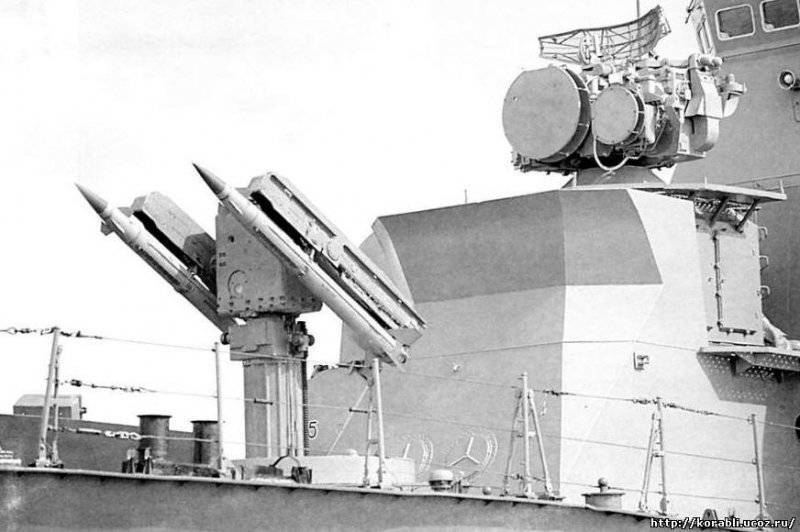
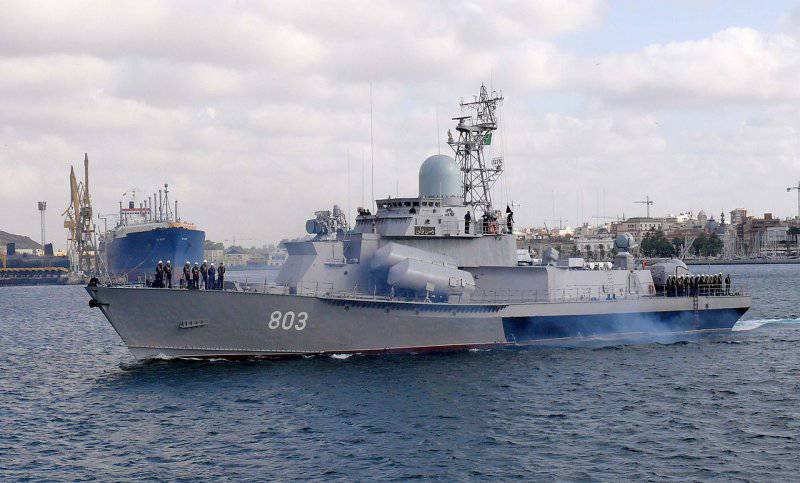
Information